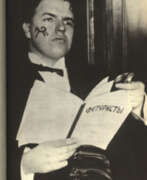Europe Neo-primitivism


David Davidovich Burliuk (Russian: Давид Давидович Бурлюк), a pioneering figure of the Russian Futurist movement, was a Ukrainian poet, artist, and publicist, born in 1882 in Semirotovshchina, Kharkov, Ukraine, and died in 1967 on Long Island, N.Y., U.S. Known for his eclectic contributions that spanned poetry, painting, criticism, and publishing, Burliuk's work was instrumental in introducing the Russian avant-garde to Europe and the United States. Despite having a lesser volume of work in poetry and painting compared to his contemporaries, Burliuk's knack for discovering talent and promoting it was unparalleled. He was among the first to publish the works of Velimir Khlebnikov and to recognize the genius of Vladimir Mayakovsky, significantly contributing to their renown.
Burliuk's artistic journey was marked by his involvement with the Futurist and Neo-Primitivist movements. His early work, including an exhibition with the group Zveno ("The Link") in Kiev in 1908 and his participation in the Hylaea group, set the stage for his later achievements. He was a co-author of the influential Futurist manifesto "A Slap in the Face of Public Taste" in 1912, advocating for a break from traditional art forms and the embrace of modernity. Burliuk's commitment to Futurism was evident in his publishing endeavors and his collaborations with notable artists of the time.
In his later years, after emigrating to the United States in 1922, Burliuk continued to engage with the art world, contributing to pro-Soviet groups and publishing his works and those of his contemporaries. His efforts were recognized in several exhibitions, including a significant show at the Brooklyn Museum's 1926 International Exhibition of Modern Art. Despite facing challenges, such as being denied permission to visit his homeland by the Soviet government, Burliuk's influence remained steadfast. His legacy as a central figure in Russian Futurism and his contributions to the broader art movement are celebrated to this day.
To stay informed about updates and events related to David Davidovich Burliuk, including sales of his works and auction events, sign up for our newsletter. This subscription will ensure you're the first to know about new discoveries and opportunities to engage with Burliuk's enduring legacy.


Nikolaу Petrovich Krymov (Russian: Никола́й Петро́вич Кры́мов), born on May 2, 1884, in Moscow, Russia, was a renowned Russian and Soviet painter and art theoretician, celebrated for his contributions to landscape painting and art education. Krymov hailed from an artistic family, and his education in the arts was comprehensive, studying under prominent figures like Abram Arkhipov, Nikolay Kasatkin, Leonid Pasternak, Valentin Serov, and Konstantin Korovin at the Moscow School of Painting, Sculpture and Architecture. His artistic journey began with participation in student exhibitions in 1906, and his works were soon featured in major exhibitions, including those of the Blue Rose, the Golden Fleece, and the Union of Russian Artists, marking his integration into significant artistic circles of his time.
Krymov's early works were significantly influenced by Isaac Levitan's delicate vision of Russian nature, focusing on the subtleties of daily transitions and the beauty of the Russian countryside. This influence is evident in Krymov's ability to convey the ethereal qualities of light and atmosphere in his landscapes, which were appreciated for their emotional depth and technical prowess. Among his notable works are paintings like "Dawn" (1908), "On the Mill" (1915), "First Snow" (1917), and "Hot Day" (1920), all of which demonstrate his masterful handling of light, shadow, and composition to capture the essence of nature.
Krymov's career also included significant contributions to art education and theory. He was an active participant in the "Blue Rose" movement, where he explored symbolism and impressionism, later transitioning towards a more classical approach in his landscapes. This evolution in style reflected his continuous search for an ideal harmony between reality and fantasy in his works. His dedication to art was recognized with several honors, including the title of Honorary Art Worker of the Russian Federation and the prestigious Order of the Red Banner of Labour.
Krymov's legacy extends beyond his paintings to include his influence on future generations of artists through his teaching and theoretical writings. His works are housed in museums and private collections, where they continue to be celebrated for their contribution to the landscape genre and Russian art.
For art collectors and experts interested in the rich tapestry of Russian landscape painting, Krymov's works offer a window into the soul of Russian nature and the artistic movements of the early 20th century. To stay updated on new product sales and auction events related to Nikolay Petrovich Krymov, signing up for updates is highly recommended. This subscription ensures that enthusiasts and collectors alike are informed about opportunities to acquire pieces by this illustrious artist, celebrating his enduring influence on the world of art.